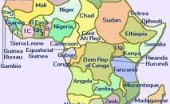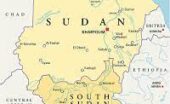Molly Minturn - My family is heartbroken to share that my father died in surgery on Monday, Feb. 10. It…
Food (in)security April 2024-
Written by Diana Thebaud Nicholson // June 8, 2024 // Agriculture & Food // Comments Off on Food (in)security April 2024-
WFP HungerMap Live
(UN World Food Programme WFP) Near real-time monitoring of food security situation in more than 90 countries set to inform better decisions.
8 June
Tens of millions of acres of cropland lie abandoned, study shows
The biggest changes took place around the Ogallala Aquifer, whose groundwater irrigates parts of numerous states, including Colorado, Texas and Wyoming.
(WaPo) About 30 million acres of U.S. cropland have been abandoned since the 1980s, a new analysis suggests. The study, published in Environmental Research Letters, offers a detailed look at land with immense environmental and economic potential — land that, researchers write, was abandoned at a rate of over a million acres a year between 1986 and 2018.
The analysis used satellite data and cropland information from the U.S. Agriculture Department to map the locations of abandoned cropland and how long it had been out of use. The researchers conclude that during the study period about 12.3 million hectares — or 30.39 million acres — of cropland went unused in the contiguous United States.
6 June
UNICEF / CHILD FOOD POVERTY REPORT
Around 181 million children worldwide under five years of age – or one in four – are experiencing severe child food poverty, making them up to 50 per cent more likely to experience wasting, a life-threatening form of malnutrition, a new UNICEF report revealed. UNICEF
For the first time, Child Food Poverty: Nutrition Deprivation in Early Childhood analyses the impacts and causes of dietary deprivation among the world’s youngest people in nearly 100 countries, and across income groups. It warns that millions of children under the age of five are unable to access and consume a nutritious and diverse diet to sustain optimal growth and development in early childhood and beyond.
Children who consume, at most, two of eight defined food groups are considered to be in severe child food poverty. Four out of five children in this situation are fed only breastmilk/milk and/or a starchy staple, such as rice, maize or wheat. Less than 10 per cent of these children are fed fruits and vegetables. And less than 5 per cent are fed nutrient-dense foods such as eggs, fish, poultry, or meat. …
The UN says a quarter of the world’s children under 5 have severe food poverty. Many are in Africa
(AP) The report, which focused on nearly 100 low- and middle-income countries, defines severe food poverty as consuming nothing in a day or, at best, two out of eight food groups the agency recognizes.
Africa’s population of more than 1.3 billion people is one of the most affected mainly due to conflict, climate crises and rising food prices. The continent accounts for one-third of the global burden and 13 of the 20 most affected countries.
But it has also recorded some progress, the report said.
The percentage of children living in severe food poverty in West and Central Africa fell from 42% to 32% over the last decade, it said, noting advances including diversified crops and performance-based incentives for health workers.
In the absence of vital nutrients, children living with “extremely poor” diets are more likely to experience wasting, a life-threatening form of malnutrition, the agency known as UNICEF said.
… Inequality also plays a role in severe food poverty among children in Africa, the new report said. In South Africa, the most unequal country in the world, roughly one in every four children is affected by severe food poverty even though it is the continent’s most developed nation.
5 June
Hunger Hotspots report: Famine looms in Gaza while risk of starvation persists in Sudan, Haiti, Mali, and South Sudan
Latest Hunger Hotspots report urges immediate action to prevent famine and warns of La Niña-linked climate extremes
(UNWFP) Acute food insecurity is set to increase in magnitude and severity in 18 hunger “Hotspots”, a new United Nations early warning report has revealed today. The report spotlights the urgent need of assistance to prevent famine in Gaza and the Sudan, and further deterioration in the devastating hunger crises in Haiti, Mali, and South Sudan. It also warns of the lingering impact of El Niño and the looming threat of La Niña that risks bringing further climate extremes that could upend lives and livelihoods.
The report found that many hotspots face growing hunger crises and highlights the worrying multiplier effect that simultaneous and overlapping shocks are having on acute food insecurity. Conflict, climate extremes, and economic shocks continue to drive vulnerable households into food crises. Furthermore, the report warns that 2023 is likely to mark the first year since 2010 in which humanitarian funding has declined compared to the previous year, but it still represents the second highest funding level ever for humanitarian assistance.
Hotspots at highest risk of deterioration
The ongoing conflict in Palestine is expected to further aggravate already catastrophic levels of acute hunger, with starvation and death already taking place, alongside the unprecedented death toll, widespread destruction and displacement of nearly the total population of the Gaza Strip – the report warns. In mid-March 2024, famine was projected to occur by the end of May in the two northern governorates of the Gaza Strip, unless hostilities ended, full access was granted to humanitarian agencies, and essential services were restored. Over one million people – half the population of Gaza – are expected to face death and starvation (IPC Phase 5) by mid-July. The report also warns of broader regional ramifications of the crisis, which risk exacerbating the already high food security needs in Lebanon and the Syrian Arab Republic.
Key Findings
According to the report, Mali, Palestine, South Sudan and the Sudan remain at the highest alert level and require the most urgent attention. Haiti was added to the list due to escalating violence and threats to food security. Conflict is the primary driver of hunger in all these areas. All hotspots of the highest concern have communities facing or projected to face starvation, or are at risk of sliding towards catastrophic conditions, given they have already emergency levels of food insecurity and are facing severe aggravating factors.
Chad, the Democratic Republic of Congo, Myanmar, the Syrian Arab Republic and Yemen are hotspots of very high concern, with a large number of people facing critical acute food insecurity, coupled with worsening drivers that are expected to further intensify life-threatening conditions in the coming months.
Since the previous edition of the Hunger Hotspots report (October 2023), the Central African Republic, Lebanon, Mozambique, Myanmar, Nigeria, Sierra Leone and Zambia have joined Burkina Faso, Ethiopia, Malawi, Somalia and Zimbabwe in the list of hunger hotspots, where acute food insecurity is likely to deteriorate further during the outlook period.
28 May
‘Crippling’ drought in Zambia threatens hunger for millions, says minister
Collins Nzovu says country’s plight is foretaste of disasters that will increasingly afflict region as climate breakdown takes hold
Severe drought in Zambia is threatening hunger for millions of people, cutting off electricity for long periods and destroying the country’s social fabric and economy, the environment minister has warned, in a harbinger of what is in store for the region as the climate crisis worsens.
Collins Nzovu said the “crippling drought” his country was experiencing hammered home the message that developing countries were facing catastrophe from the climate crisis, even as richer countries failed to muster financial help for the most afflicted.
“What has happened this year is that we received well below the normal rainfall. This has been a crippling drought,” he said. “We’ve had a huge crop failure. A lot of people who depend on maize, who depend on agriculture for their very survival, face starvation and hunger.”
27 May
Access to Aid in Gaza Was Dire.
Now, It’s Worse.
By Amy Schoenfeld Walker and Elena Shao
(NYT) The flow of aid into Gaza has shrunk so much in May that humanitarian officials say their operations are at risk of shutting down, and that the threat of widespread starvation is more acute than ever.
Aid trucks entering Gaza fall far short of meeting need
21 May
5 ways that free trade can boost sustainable agriculture in Africa
Africa could become the world’s powerhouse, particularly with the African Continent Free Trade Area (AfCFTA) seeking to remove trade barriers.
AfCFTA is key to implementing the Agenda 2063 goals, which include healthy citizens and modern agriculture for increased productivity and production.
Here are five focus areas to drive the Africa’s agriculture and food production from potentiality to sustainability by leveraging the benefits of the AfCFTA.
(WEF) The continent is undergoing unprecedented changes, with the implementation of the African Continent Free Trade Area (AfCFTA) – which aims to eliminate trade barriers and boost intra-African trade – projected to represent a single market of 1.7 billion people and $6.7 trillion in consumer and business spending for the region by 2030.
AfCFTA is widely seen as a key step in implementing the Africa Union’s Agenda 2063, which aspires to create a prosperous Africa based on inclusive growth and sustainable development. This includes specific goals such as creating a high standard of living for all citizens, a healthy and well-nourished populace and modern agriculture for increased productivity and production.
9 May
AI in Agriculture — The Future of Farming
Increase yields, reduce costs, and develop a more sustainable ecosystem using AI in agriculture
(Intellias) The growth of the global population, which is projected to reach 10 billion by 2050, is placing significant pressure on the agricultural sector to increase crop production and maximize yields. To address looming food shortages, two potential approaches have emerged: expanding land use and adopting large-scale farming, or embracing innovative practices and leveraging technological advancements to enhance productivity on existing farmland
3 May
Israel’s offensive is destroying Gaza’s ability to grow its own food
More than six months into Israel’s invasion of Gaza, the Strip’s ability to produce food and clean water has been severely hampered.
(WaPo) Israeli airstrikes and bulldozers have razed farms and orchards. Crops abandoned by farmers seeking safety in southern Gaza have withered, and cattle have been left to die.
A Post analysis of agricultural data, satellite imagery and interviews with experts and Palestinians in the Strip reveals how an already vulnerable agricultural system is on the brink of collapse.
Asked for comment on the level of destruction in Gaza’s agricultural sector, the Israel Defense Forces said, “Hamas and other terror organizations unlawfully embed their military assets in densely populated civilian areas.” The IDF added that its actions are “based on military necessity and in accordance [with] international law.
26 April
Nearly 23% of the Canadian population reported food insecurity in 2022
Food insecurity numbers are ‘sickening’ but not surprising, says researcher


